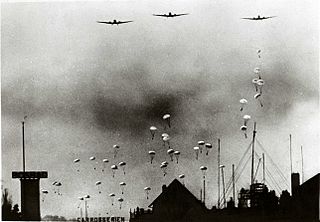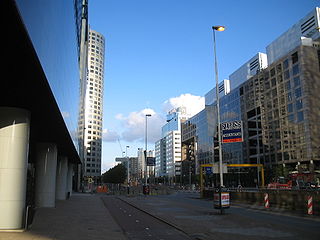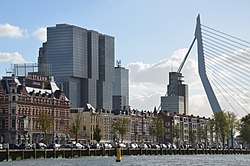
Rotterdam is the second-largest city in the Netherlands after the national capital of Amsterdam. It is in the province of South Holland, part of the North Sea mouth of the Rhine–Meuse–Scheldt delta, via the "New Meuse" inland shipping channel, dug to connect to the Meuse at first and now to the Rhine.

Sparta Rotterdam is a Dutch professional football club based in Rotterdam. Established on 1 April 1888, Sparta Rotterdam is the oldest professional football team in the Netherlands.

Rozenburg is a town and former municipality in the western Netherlands, in the province of South Holland. The municipality had a population of 13,173 in 2004, and covers an area of 6.50 km². It was the second-smallest municipality in the Netherlands in area. On 10 July 2008, the local council decided to disband the municipality and to form a submunicipality of Rotterdam. This was ratified on 27 October 2008 by the Eerste Kamer, and came into effect on 18 March 2010.

Wassenaar is a municipality and town located in the province of South Holland, on the western coast of the Netherlands.

Despite Dutch neutrality, Nazi Germany invaded the Netherlands on 10 May 1940 as part of Fall Gelb. On 15 May 1940, one day after the bombing of Rotterdam, the Dutch forces surrendered. The Dutch government and the royal family relocated to London. Princess Juliana and her children sought refuge in Ottawa, Canada until after the war.

Willem Marinus Dudok was a Dutch modernist architect. He was born in Amsterdam. He became City Architect for the town of Hilversum in 1928 where he was best known for the brick Hilversum Town Hall, completed in 1931. Not only did he design the building, but also the interior including the carpets, furniture and even the mayor's meeting hammer. He also designed and built about 75 houses, public buildings and entire neighborhoods.

Municipal Museum Boijmans Van Beuningen is an art museum in Rotterdam in the Netherlands. The name of the museum is derived from the two most important collectors of Frans Jacob Otto Boijmans and Daniël George van Beuningen. It is located at the Museumpark in the district Rotterdam Centrum, close to the Kunsthal and the Natural History Museum.

ASWH, short for Altijd Sterker Worden Hendrik-Ido-Ambacht, is an association football club from Hendrik-Ido-Ambacht, Netherlands. The club was founded in 1929. The club won section championships in 1949, 1959, 1961, 1970, 1883, 1999, 2001, 2002, and 2005. In 2005 it also won the Dutch Championship of Amateur Soccer and the Dutch Championship of Saturday Soccer. Ascending gradually through the ranks, ASWH played 2019–2022 in the semi-professional Tweede Divisie. In 2023, it joined the Vierde Divisie, after having relegated twice for the first time in the club's history.

The Battle for The Hague was a battle fought on 10 May 1940 during the Battle of the Netherlands. German Fallschirmjäger units were dropped in and around The Hague to capture Dutch airfields and the city itself.

The Witte Huis or White House is a building and National Heritage Site in Rotterdam, Netherlands, built in 1898 in the Art Nouveau style. The building is 43 m (141 ft) tall, with 10 floors. It was also the first hoogbouw in Europe. The building is listed as a Rijksmonument.

Koningsdag or King's Day is a national holiday in the Kingdom of the Netherlands. Celebrated on 27 April, the date marks the birth of King Willem-Alexander. When the Dutch monarch is female, the holiday is known as Koninginnedag or Queen's Day and, under Queen Beatrix until 2013, was celebrated on 30 April.

The Rotte is a river in the Rhine-Maas-delta in the Netherlands. The Rotte is the eponym of the city of Rotterdam: the city was founded in the 13th century when a dam was built along the river.

The Maastoren is with its height of 165 metres the second tallest building in the Netherlands. The office building is situated on the bank of the Nieuwe Maas, after which the building is named, in the neighborhood Kop van Zuid in the South Holland city of Rotterdam. The Maastoren was built between 2006 and 2009, and had OVG as its developer. The Maastoren has a total of 44 above ground floors and two underground floors.
Albert Alberts, writing as A. Alberts (1911–1995) was a Dutch writer, translator, and journalist. He won numerous awards throughout his career, among them the 1975 Constantijn Huygens Prize.

Werkspoor N.V. was the shortened, and later the official name of the Nederlandsche Fabriek van Werktuigen en Spoorwegmaterieel. It was a Dutch machine factory, known for rolling stock, (ship) steam engines, and diesel engines. It was a successor of the company Van Vlissingen en Dudok van Heel, later named Koninklijke Fabriek van Stoom- en andere Werktuigen. In 1954 Werkspoor was merged with Stork.

Rotterdam was subjected to heavy aerial bombardment by the Luftwaffe during the German invasion of the Netherlands during the Second World War. The objective was to support the German troops fighting in the city, break Dutch resistance and force the Dutch army to surrender. Bombing began at the outset of hostilities on 10 May and culminated with the destruction of the entire historic city centre on 14 May, an event sometimes referred to as the Rotterdam Blitz. According to an official list published in 2022, at least 1,150 people were killed, with 711 deaths in the 14 May bombing alone, and 85,000 more were left homeless.

Weena is a street with many highrises in the center of Rotterdam, Netherlands. It defines the Rotterdam skyline. The street of about 1 kilometer length leads east-west from Hofplein to Beukelsdijk.

Fijenoord was a shipbuilding company and machine factory in Rotterdam the Netherlands from 1823 to 1929. In 1929 it merged with Wilton to become Wilton-Fijenoord.

The oldest Rhine shipping company for bulk goods W. van Driel Stoomboot- & Transportbedrijven was founded in 1888 by Willem van Driel sr. (1845-1911), with headquarters on the Noordereiland in Rotterdam on the Maaskade to operate a tugboat company and to focus on mass transport to the Rhine of grain, ore, etc.



















